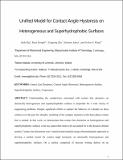Unified Model for Contact Angle Hysteresis on Heterogeneous and Superhydrophobic Surfaces
Author(s)
Raj, Rishi; Enright, Ryan; Zhu, Yangying; Wang, Evelyn N.; Adera, Solomon E.
DownloadMain Article (including Supplementary Information) (2.795Mb)
PUBLISHER_POLICY
Publisher Policy
Article is made available in accordance with the publisher's policy and may be subject to US copyright law. Please refer to the publisher's site for terms of use.
Terms of use
Metadata
Show full item recordAbstract
Understanding the complexities associated with contact line dynamics on chemically heterogeneous and superhydrophobic surfaces is important for a wide variety of engineering problems. Despite significant efforts to capture the behavior of a droplet on these surfaces over the past few decades, modeling of the complex dynamics at the three-phase contact line is needed. In this work, we demonstrate that contact line distortion on heterogeneous and superhydrophobic surfaces is the key aspect that needs to be accounted for in the dynamic droplet models. Contact line distortions were visualized and modeled using a thermodynamic approach to develop a unified model for contact angle hysteresis on chemically heterogeneous and superhydrophobic surfaces. On a surface comprised of discrete wetting defects on an interconnected less wetting area, the advancing contact angle was determined to be independent of the defects, while the relative fraction of the distorted contact line with respect to the baseline surface was shown to govern the receding contact angle. This behavior reversed when the relative wettability of the discrete defects and interconnected area was inverted. The developed model showed good agreement with the experimental advancing and receding contact angles, both at low and high solid fractions. The thermodynamic model was further extended to demonstrate its capability to capture droplet shape evolution during liquid addition and removal in our experiments and those in literature. This study offers new insight extending the fundamental understanding of solid–liquid interactions required for design of advanced functional coatings for microfluidics, biological, manufacturing, and heat transfer applications.
Date issued
2012-10Department
Massachusetts Institute of Technology. Department of Mechanical EngineeringJournal
Langmuir
Publisher
American Chemical Society (ACS)
Citation
Raj, Rishi, Ryan Enright, Yangying Zhu, Solomon Adera, and Evelyn N. Wang. “Unified Model for Contact Angle Hysteresis on Heterogeneous and Superhydrophobic Surfaces.” Langmuir 28, no. 45 (November 13, 2012): 15777–15788.
Version: Author's final manuscript
ISSN
0743-7463
1520-5827